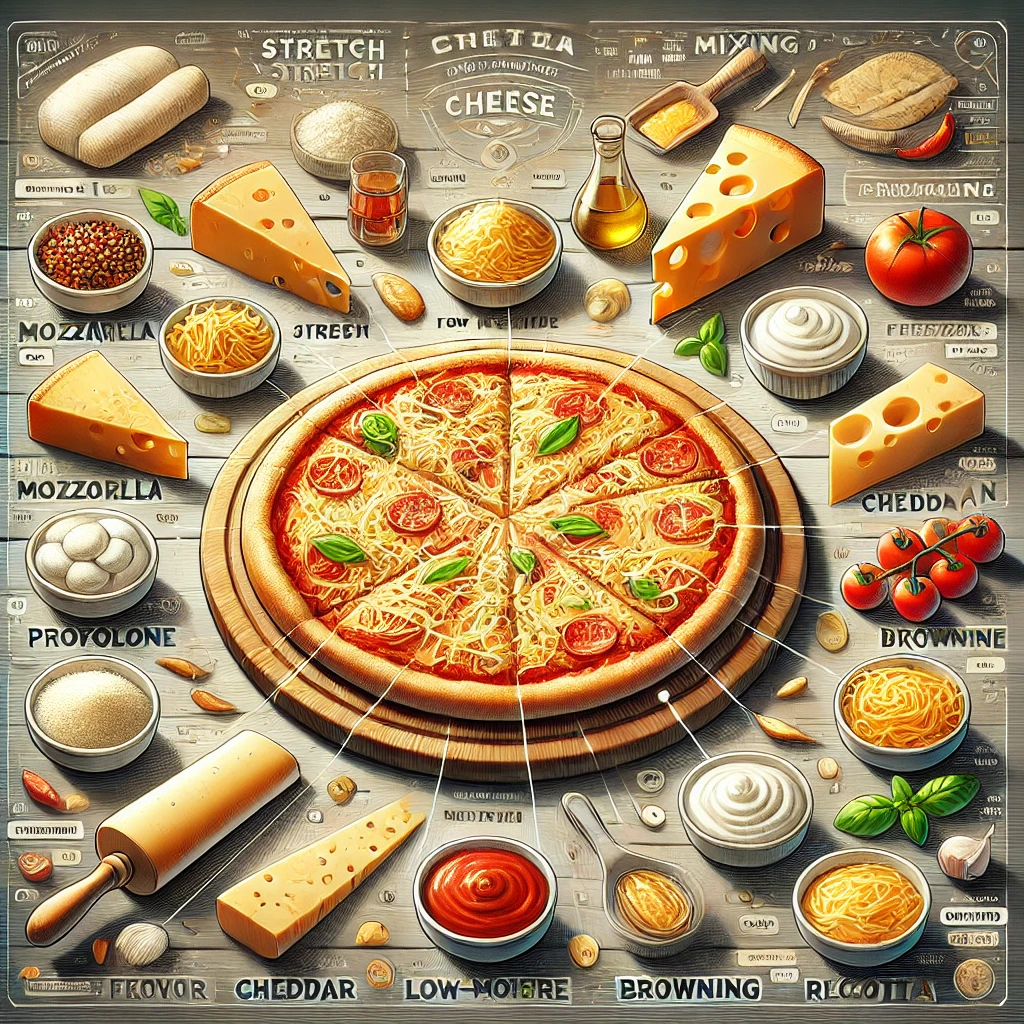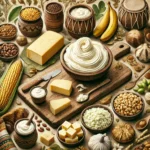When people talk about great pizza, they often focus on dough or sauce. But in reality, cheese is the heart of the perfect pie. The right pizza cheese creates stretch, melt, flavor balance, and visual appeal. The wrong cheese can make a pizza greasy, dry, rubbery, or bland.
From classic mozzarella to creative blends that elevate flavor and texture, understanding pizza cheese transforms home baking and professional pizza-making alike. This guide explains how to choose the right pizza cheese, how to use it correctly, and how to mix cheeses for the perfect pizza every time.
Whether you’re making Neapolitan pizza, New York–style slices, pan pizza, or homemade pies, mastering cheese selection is a game changer.
What Makes a Cheese Good for Pizza?
Not all cheeses are pizza-friendly. The best pizza cheeses share a few essential qualities.
Key Characteristics of Great Pizza Cheese
-
Good melting behavior
-
Balanced moisture content
-
Pleasant stretch without toughness
-
Flavor that complements sauce and toppings
-
Even browning without burning
Cheeses that lack these qualities often leak oil, burn too fast, or overpower the pizza.
Mozzarella: The Gold Standard of Pizza Cheese
Why Mozzarella Is the Most Popular Pizza Cheese
Mozzarella dominates pizza for good reason. It melts smoothly, stretches beautifully, and has a mild flavor that lets other ingredients shine.
Types of Mozzarella for Pizza
Low-Moisture Mozzarella
-
Most common for pizza
-
Excellent melt and stretch
-
Less water, more control
Fresh Mozzarella
-
Creamy and delicate
-
Best for Neapolitan-style pizza
-
Can release water if overused
Low-moisture mozzarella is the safest and most versatile option for consistent results.
Beyond Mozzarella: Popular Pizza Cheeses Explained
While mozzarella is essential, other cheeses bring depth and character.
Cheddar
-
Adds sharpness
-
Enhances color
-
Best used in blends
Provolone
-
Mild, slightly tangy
-
Improves melt and aroma
-
Great companion to mozzarella
Monterey Jack
-
Smooth melt
-
Mild buttery flavor
-
Excellent for creamy blends
Parmesan
-
Hard and salty
-
Used sparingly for umami
-
Best grated on top or mixed lightly
Asiago
-
Nutty and complex
-
Stronger than mozzarella
-
Ideal for gourmet pizzas
Each cheese contributes something unique when used correctly.
Choosing the Right Cheese for Pizza Style
Different pizza styles benefit from different cheese choices.
Neapolitan Pizza
-
Fresh mozzarella
-
Minimal cheese
-
Focus on balance
New York–Style Pizza
-
Low-moisture mozzarella
-
Even coverage
-
Classic stretch
Chicago Deep Dish
-
Mozzarella slices
-
Cheese under sauce
-
Structural integrity
Pan Pizza
-
Mozzarella blends
-
Rich, crispy edges
-
More cheese allowed
Matching cheese to style prevents texture and moisture problems.
Cheese Blends: The Secret to Better Pizza
Using a blend of cheeses often produces better results than a single cheese.
Benefits of Cheese Blending
-
Improved melt
-
Better browning
-
More complex flavor
-
Controlled oil release
Professional pizzerias almost always use blends.
Best Pizza Cheese Blends to Try
Classic Blend
-
80% mozzarella
-
20% provolone
Balanced, smooth, and versatile.
Flavor Boost Blend
-
70% mozzarella
-
20% Monterey Jack
-
10% Parmesan
Creamy with savory depth.
Sharp & Savory Blend
-
70% mozzarella
-
20% cheddar
-
10% Parmesan
Bold flavor with excellent melt.
Gourmet Blend
-
60% mozzarella
-
20% provolone
-
10% asiago
-
10% Parmesan
Perfect for artisan-style pizzas.
How Much Cheese Should You Use on Pizza?
More cheese does not mean better pizza.
Cheese Quantity Guidelines
-
Too little: Dry, bland pizza
-
Too much: Greasy, soggy crust
A general rule is 100–120 grams (3.5–4 oz) of cheese for a 12-inch pizza. Adjust slightly based on cheese type and moisture.
Shredded vs Sliced vs Fresh Cheese
Shredded Cheese
-
Even melt
-
Best coverage
-
Ideal for most styles
Sliced Cheese
-
Traditional for deep dish
-
Structured layers
-
Slower melt
Fresh Cheese
-
Soft texture
-
Add after baking or late in bake
-
Requires careful moisture control
Shredding cheese yourself produces better results than pre-shredded versions.
Pre-Shredded vs Freshly Shredded Cheese
Pre-shredded cheese contains anti-caking agents that affect melting.
Freshly Shredded Cheese Advantages
-
Better melt
-
Creamier texture
-
No additives
For best pizza quality, shred cheese at home whenever possible.
Moisture Control: A Critical Cheese Skill
Excess moisture ruins pizza texture.
How to Reduce Cheese Moisture
-
Pat fresh mozzarella dry
-
Use low-moisture cheese
-
Avoid overcrowding toppings
-
Bake at high temperature
Moisture management is as important as cheese selection.
Cheese Placement on Pizza
Where you place cheese matters.
Common Methods
Cheese on Sauce (Classic)
-
Even melt
-
Balanced flavor
Cheese Under Sauce (Deep Dish)
-
Prevents burning
-
Structural support
Cheese After Baking
-
Fresh cheese flavor
-
Visual appeal
Choose placement based on style and bake time.
Baking Temperature and Cheese Behavior
Cheese reacts differently at different temperatures.
Ideal Pizza Baking Temperatures
-
Home oven: 250–290°C (480–550°F)
-
Pizza stone or steel recommended
-
High heat = better melt, less grease
Low temperatures cause oil separation and uneven melt.
Common Pizza Cheese Mistakes
Avoid these frequent errors:
-
Using only strong cheeses
-
Adding cheese edge-to-edge
-
Using cold cheese straight from fridge
-
Overloading toppings
-
Baking too long
Small adjustments dramatically improve results.
Health and Nutrition Considerations
Cheese is rich but nutritious.
Nutritional Benefits
-
Protein
-
Calcium
-
Vitamins A and B12
Moderation and balance are key, especially with rich blends.
Vegan and Dairy-Free Pizza Cheese Options
Plant-based pizza cheeses have improved significantly.
Tips for Vegan Pizza Cheese
-
Choose brands designed for melting
-
Use sparingly
-
Combine with olive oil for better texture
They won’t mimic dairy perfectly, but they work well with the right approach.
Professional Tips for the Perfect Cheese Pizza
-
Always balance moisture and fat
-
Blend cheeses for complexity
-
Use high heat and quick bakes
-
Let pizza rest briefly before slicing
Consistency comes from technique, not just ingredients.
Why Cheese Defines Pizza Quality
Cheese affects:
-
Flavor balance
-
Texture and mouthfeel
-
Visual appeal
-
Overall satisfaction
A great crust and sauce can be ruined by poor cheese choices—but the right cheese elevates everything.
Conclusion
Choosing the right pizza cheese is both an art and a science. From understanding mozzarella’s role to mastering cheese blends and moisture control, every decision shapes the final result. Whether you prefer classic New York slices, rustic Neapolitan pies, or creative gourmet pizzas, cheese is the defining ingredient that brings everything together.
By selecting quality cheeses, using the right amounts, blending intelligently, and baking properly, you can consistently create pizzas that are flavorful, stretchy, and perfectly balanced. Great pizza isn’t about more cheese—it’s about the right cheese, used the right way.
Frequently Asked Questions (FAQ)
What is the best cheese for pizza?
Low-moisture mozzarella is the best base cheese for most pizzas.
Can I mix different cheeses on pizza?
Yes, blending cheeses improves flavor, melt, and texture.
Why does my pizza get greasy?
Too much cheese, low oven temperature, or high-fat cheeses can cause greasiness.
Is fresh mozzarella better than shredded?
Fresh mozzarella is excellent for some styles, but low-moisture mozzarella is more reliable.
How much cheese should I use on a 12-inch pizza?
About 100–120 grams (3.5–4 oz) is ideal for balanced results.



